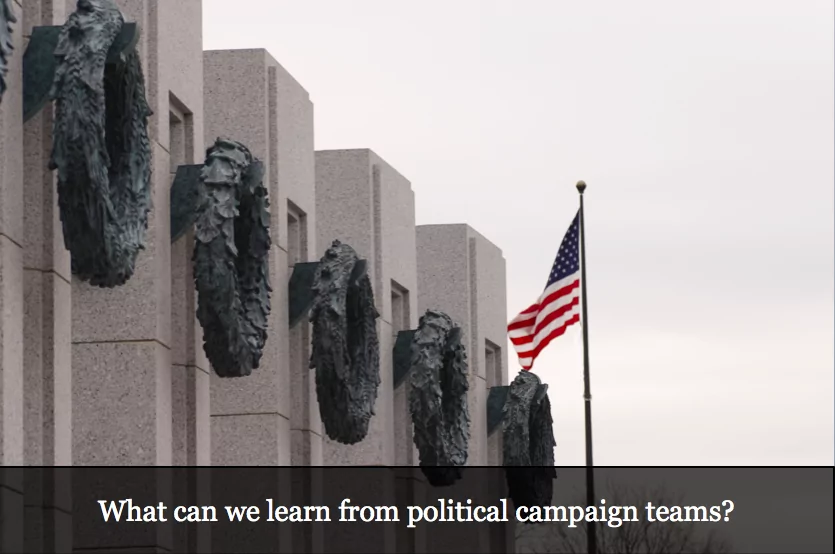Is Your Campaign Team Ready? Training Under Pressure

Chances are, you are not a presidential hopeful, but even if you aren’t, you likely have something to learn from how campaign teams are onboarded and trained.
A recent article in the New York Times described campaign teams as the “ultimate start up,” and there is some truth to this claim. Successful campaign teams need to be brought together quickly, hit the ground running, and maintain their stamina—ideally, without a single stumble—to the finish line. This means finding exceptional talent and more importantly, finding exceptional talent who are able and willing to  walk away from their current positions for just a few short months and to work for lower compensation than usual. It also means assembling a team of experts with the personal dynamics required to work together up to fourteen hours of day, often under stressful conditions, and who have the leadership skills required to train hundreds of interns and unpaid volunteers across the country.
walk away from their current positions for just a few short months and to work for lower compensation than usual. It also means assembling a team of experts with the personal dynamics required to work together up to fourteen hours of day, often under stressful conditions, and who have the leadership skills required to train hundreds of interns and unpaid volunteers across the country.
To fully appreciate why onboarding and training a campaign team is an important step, one need only consider what happens when campaign teams are not as prepared as they should be.
False Facts: Michele Bachmann was a Republican presidential candidate in 2011. Originally from Iowa, Bachmann claimed to be from the same town as John Wayne. While this was partially true, Bachmann’s facts about her hometown were not fully accurate. In fact, John Wayne, the actor, is from Winterset, Iowa, and John Wayne Gacy, a notorious serial killer, is from Waterloo, Iowa–Bachmann’s hometown. Conflating the two John Waynes proved an unforgivable error and cost Bachmann her campaign. In this case, Bachmann’s local advisory team missed a step by failing to properly advise her on a grim local fact.
Bad Spin: Taking a vacation in the middle of a campaign is never a good idea, but responding to criticisms by putting a new spin on the vacation may be worse. This is precisely what happened to Newt Gingrich in 2011 when he opted to take a vacation to the Greek Islands and later repackaged the vacation as a “fact-finding mission.” Unfortunately, no clear case was ever made for how the fact-finding mission was relevant to Gingrich’s campaign. While advisors’ apparently discouraged him from taking the vacation, their subsequent spin on the vacation did more damage than good.
Failed Photo-ops: One of the worse public relations events in US political history occurred in 1988 when Michael Dukasis’s campaign team attempted to prove his commitment to the military by arranging for a photo-op that placed Dukasis on top of a tank. Rather than cement Dukasis as a trusted leader who would not cut military spending, the photo-op backfired. The image of Dukasis, a Democrat candidate smiling on top of a tank, was considered inauthentic and hilarious by most journalists and was easily co-opted by his rival, George Bush. “Dukasis on a tank” continues to be used as shorthand for political photo-ops gone wrong.
Could the above errors have been avoided? While everyone makes mistakes, the above mistakes likely could have been avoided with more information, smarter strategy and a more keen sense of visual optics. Bear in mind that it was a 23-year-old political rookie who ultimately arranged the disastrous Dukasis photo-op. So how does one avoid such moments? As new presidential hopefuls continue to announce their intentions, there is no doubt that behind the scenes, thousands of core staff and volunteers are gearing up for the race. Among other key steps, each team must attend to the following:
Assemble Leaders: First and foremost, running a campaign means recruiting people with leadership skills. In this case, however, the real leader is the candidate in the running, so campaign team leaders also need to be leaders who are willing to stay out of the spotlight. In short, they need to be experts in their field (management, analysis, research, communications or finance) who able and willing to lead quietly and efficiently.
Onboard and Train Volunteers: Volunteers are the bedrock of any campaign but enthusiasm for a candidate and/or specific platform does not necessarily mean knowledge of the issues. Onboarding and training volunteers is arguably one of the most important jobs on any campaign team. Having an experienced trainer on hand is therefore essential. It’s also important to ensure that training happens on a continuous basis. After all, as new issues emerge during a campaign, one needs to retrain their enthusiastic volunteers.
Develop a Decision Making Structure: From the onset, campaigns need to determine which decisions should be made in a centralized and decentralized manner. For example, while decisions about communications may be best carried out in a centralized manner, photo-ops may not. After all, someone in Hilary Clinton’s campaign office in Brooklyn may not realize that a photo-op in a farmer’s field in Texas may require the candidate to don garish rubber boots and negotiate large puddles of mud (said another way, it could be a “Dukasis in the tank” moment).
What can we learn from political campaign teams? In short, watching how political campaign teams operate offers insight into how to recruit workers, train them and train them to train interns and volunteers in a short span of time under stressful conditions. More importantly, we can learn from campaign teams’ mistakes. After all, like any other company, a campaign team has a brand that they are attempting to promote and protect. Campaign teams, in a sense, offer a great example of how and how not to engage in risk and reputation management.